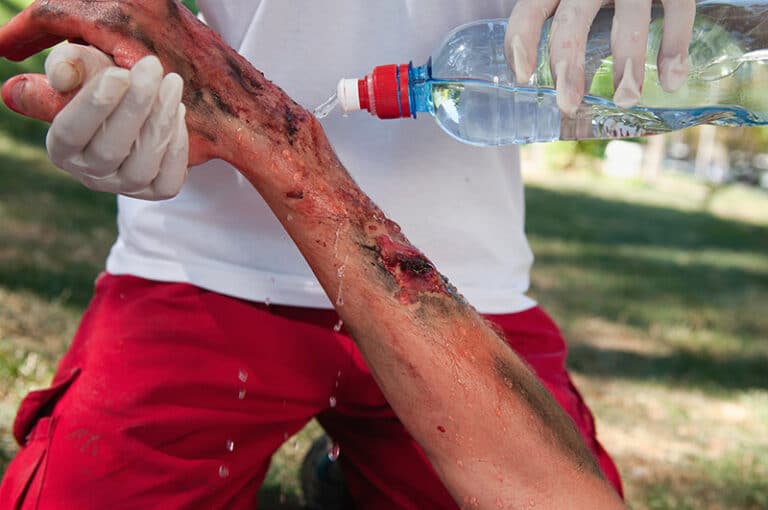The following essay about how chronic pain can affect all aspects of life was written and submitted by a client for publication on our website. Helping people manage the financial and emotional stress caused by catastrophic injuries and life-altering pain is why we come to work every day.
Hell: The Art and Science of Being in a Body That Hurts
by Tracy E. Houston, MA

I felt my pain constantly. Demanding is not a big enough word to hold what chronic pain does to a person. A force of nature, it is internal, an enemy within. It ate my soul. Even in sleep I hurt. Pain hogged, pushed, tormented, occupied and annihilated me. How? Through attention. It was four years and 200+ provider appointments before I found partial relief. It never asked: It took.
Chronic pain, with its trauma and distinctive form of suffering, changes a person forever. Most of the time we realize that life is ever changing but chronic pain has a sharp, relentless brutal sense that burrows deep in a person’s psyche, bringing with it a new forced reality. I find it helpful to explain this concept in this way: A person with chronic pain is here but is forced to be in another place, much like the virtual reality goggles that allow our experience to be here while we are taken to another place. The difference is that with chronic pain you are forced to live in the suffering reality and you remember what reality was before you had the pain. Change from chronic pain has the power to hurt so deeply it feels like a wound to the soul, continually, that ultimately drains the sufferer’s vitality. As a result, there is a lingering sense of ruin. Death even. Given this forced reality, one has to be very thoughtful about what type of provider can really help you be creative about how to live in these circumstances– live while dying mini-deaths.
Of note for me are some of the common touchstones referenced when dealing with chronic pain, like resilience and patience. I would also like to introduce three concepts I have created a name and a definition for. The first is trauma death experience (TDE).
Trauma Death Experience (TDE). A ruthless, catapulting where your life is snatched from you and you now live in a no man’s land without preparation or defense.
There are striking differences and applications for resilience, patience and TDEs. The current trend is to speak of resilience as the answer to many of the difficult situations we find ourselves in. Today, we are hearing a lot more about trauma in the media and the field of psychology. Here are some thoughts on what is being said and what is between the lines:
Resilience: There is some sense of balance. Elasticity. Some sense of a familiar place. Strength of will. Just hold on, try to adapt and the circumstance with become easier. You can and will return to what was. Don’t break. Bounce back. Be a leader. Look at the big picture. You will be admired. Time is limited, scarce even. Transformation has very little presence in this thought, content and research. Basically, in a big wind (trauma or suffering), the tree bends but will become upright once again.
Patience: Recognize suffering. Confront. Develop understanding. Face loss. Be virtuous. Recognize parts that are broken. Be with sorrow. It is more about depth than time. Unlike resilience, which implies returning to an original shape, patience suggests change and allows the possibility of transformation as a means of overcoming difficulties. In a big wind (trauma or suffering) the tree is deeply bent over and life begins in new ways.
Trauma Death Experience: Personhood death. “I did not die, and yet I lost life’s breath” As Dante says in the Inferno section of The Divine Comedy. You feel as though you are in another world, more real than the one you knew. You experience physical, emotional, spiritual and existential distress all at once. Time and suffering are merged. Transformation comes in the form of mini-deaths. In a big wind (trauma or suffering) the tree is blown over, the ground is inconsistent and new life may or may not begin.
The idea of resilience and the recent psychological findings have some sexy toughness to them and are certainly easily digestible. For a chronic pain sufferer, the focus on resilience is striking in its ability to make absent grief; it basically ignores it. While I am heartened that we are more open to speaking about and dealing with trauma, suffering and loss, for me, the content in books and articles on resilience is shallow, borders on deceptive and has nothing that helps me in the truths of living with chronic pain and loss. Patience, on the other hand, places more emphasis on depth, offering me some honor for my soul as I am suffering. Neither resilience or patience is easy. TDEs are an animal like no other. When I first came up with the term TDE, I asked myself: Is there anyone who is brutally honest about TDE so that I can buy a book about it? Look on a provider’s website and read about it?
I find myself in all three states at differing stages of the pain. In resilient mode, I want to return to my old life. In patient mode, I come a little closer to the loss and grief. As the vitality of my life is drained, I pass a threshold and know internally I am at a TDE. I feel part of myself being taken away. Parts of me are dying. I would like to suggest that providers take steps toward a cultivation of a posture to help those in chronic pain. This brings me to my second concept that I would like to introduce which is Uncertainty Posture (UP)
Uncertainty Posture (UP): An approach that allows for mystery over certainty. The provider holds the uncertainty and sees it for what it is—is able to be with grappling. One who knows the ultimate touchstones of humanness is witness – to accompany.
Some will be able to do this, some will not. Some are already doing this. It is more than the emotional labor of a job. Emotional labor, like the flight attendants on an airplane helping people to feel comfortable, is important work. The flight attendant stands separate, has both intellectual and emotional understanding of possible discomfort a human may feel coming into an airplane’s small space and being still for long periods of time. While emotional labor is starting to be acknowledged as part of “work,” what I am after in naming and defining an uncertainty posture is a more encompassing endeavor. I would propose using the word ‘integral’ which implies that bodily, intellectual, emotional, spiritual, and interpersonal aspects are represented in the work. At differing times, the provider would accompany the chronic pain sufferer in the suffering and deaths that occur in all five of the areas.
The third and final term might be “Integral Uncertainty Posture (IUP)”
In my mind, an IUP requires a provider to be “porous” enough to accompany the true chronic pain expert (the sufferer) into the areas of suffering and death. So, be able to both merge and then become separate. The main work (the merge) is to witness. To be human. To accompany. Not try to change the situation. Not try to heal. The purpose would be to help a chronic pain sufferer to feel accompanied, witnessed, heard. Be with me in the unknown. Hear who I am in this place. Hear what is dying. This would soothe some of the aloneness that is part of chronic pain. I use the term some deliberately because the forced reality that comes with chronic pain leaves a person feeling, “I am all alone and no one is coming to get me.” That is the reality of it. There is only one person in a body that hurts–you. Specifically, accompany, through an IUP, the part of life in a chronic pain sufferer that is dead or dying. This would help bring human connection to the most difficult effects of chronic pain. Be present and spend time with this form of death. Ask: What died since our last visit? This is healthy confrontation. Stand by the coffin, if you will, and take it all in. Live the death. Witness it. Honor it. An IUP could provide a framework that is both structured and unstructured enough to embrace some of the mystery of chronic pain.
It has been my experience that a mixture of confrontation and compassion are needed. I have found in my Hakomi therapy sessions these two elements, a complexity that can be helpful in the new ground of a forced reality with TDE. Hakomi, a Native American Indian word means “Where do I stand in relation to the many realms?” From my experience I would say, “Who am I in these many realms?” For me, the hardest places/realms are ones where I am experiencing or have experienced TDEs. Fortunately, with the help of my Hakomi therapist, I am able to tap inner resources that are present from deep within: Divine Light, passed relatives who loved me and images that sustain me like large trees. This is sobering real soul work. The payoff is that I feel accompanied. The grief is softened.
Much like the experience of virtual reality goggles, chronic pain is a place of several realities at the same time, and that takes courage to be in, for both the sufferer and the provider. Moreover, adding to the mystery of chronic pain is the individual experience. Both these factors may be why relief from chronic pain is hard to find. Providers who are best in this space have experience with grief and methods that guide a person to their inner resources; I am finding both in my Hakomi therapy. At the time of writing, I am at 275+ provider appointments and am still in pain. Thankfully, the pain has decreased.
By Tracy E. Houston, MA, Auto accident survivor. speaker, author. She can be reached at: winecountytravel@gmail.com







